Seeded Scottish Oatcakes
Seeded Scottish Oatcakes are easy, wholesome savoury biscuits or crackers packed with nutritious seeds and oats. But not only are they good for you, I think you’ll love their toasted, nutty flavour and crunchy texture.

Great with cheese, pâté, nut butters, or alongside soup, they’re so good, you can even snack on them just as they are.
Containing just oats, seeds, seasoning, oil and water, Seeded Scottish Oatcakes are so simple and will keep fresh for a month.
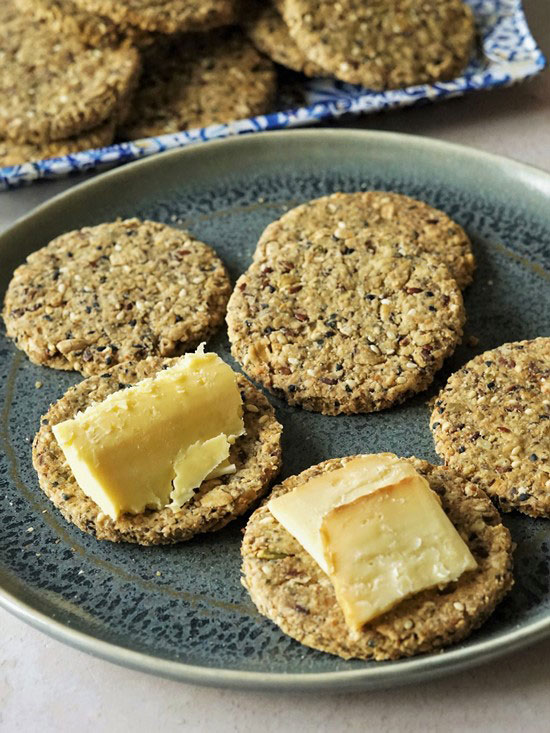
Jump to Recipe
SCOTTISH OATCAKES
If you don’t know already, Scottish oatcakes are traditional savoury biscuits or crackers. Often thought of as an accompaniment to cheese, it seems that in their homeland they were a major source of carbohydrate so would originally have been served with all sorts of meals. As well as topping with pâté, nut butters, or dips like hummus, I think they’re good alongside soups too.

By the way, although you may think of them as simply ‘oatcakes’, here in the Staffordshire Moorlands I need to refer to these crackers as Scottish oatcakes. That’s because, to us, an ‘oatcake’ is a type of pancake often stuffed with bacon or sausage and cheese. Get my recipe for Staffordshire Oatcakes here.
Anyway, I’ve been making Scottish oatcakes for a number of years now. Apart from the fact that many shop bought brands contain environmentally disastrous ‘sustainable’ palm oil, I think there’s huge satisfaction in making your own. And, in my opinion, they happen to taste much better.
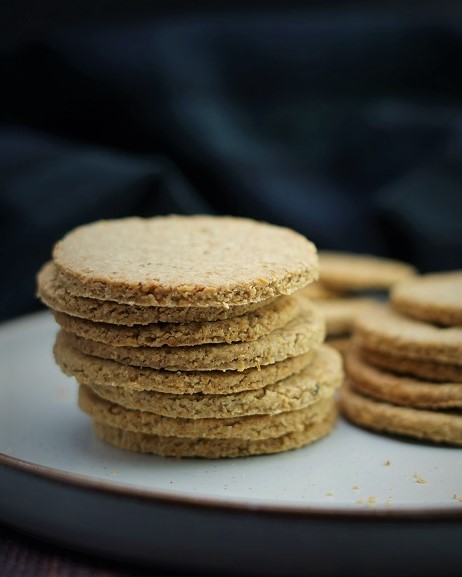
Scottish oatcakes are also incredibly easy to make with very simple ingredients. My original Scottish Oatcakes recipe contains just oats, salt, olive oil (or butter) plus water. From that base, I created two flavoured versions: Cheesy Scottish Oatcakes and Walnut & Pumpkin Seed Scottish Oatcakes.
Which brings me to my latest development: Seeded Scottish Oatcakes.
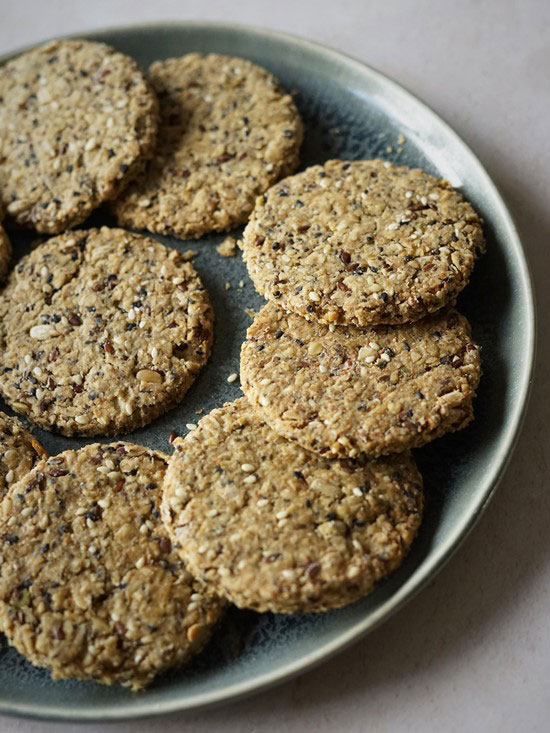
SEEDED SCOTTISH OATCAKES
Incorporating a generous amount of seeds in my basic oatcake dough transformed both the taste and texture. Once baked, the seeds gave the oatcakes a wonderful, toasted dimension. Added to their crispness were little nuggets of extra crunchiness which just made them even more satisfying.
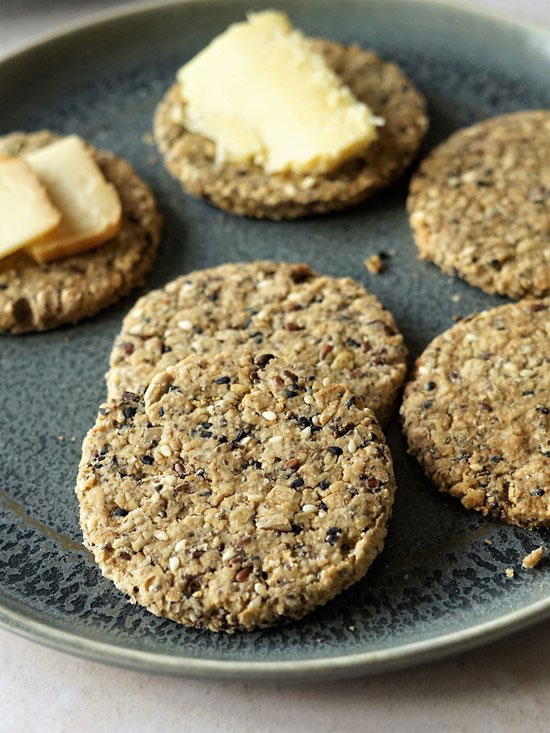
THE SEEDS
While it’s thought that eating seeds provides us with health benefits, I must confess that I mainly eat seeds because I like their flavour and texture. I always keep a variety in the cupboard, my stash usually including as a minimum sunflower, pumpkin, sesame, flax, and chia, plus hemp hearts when I can get them.
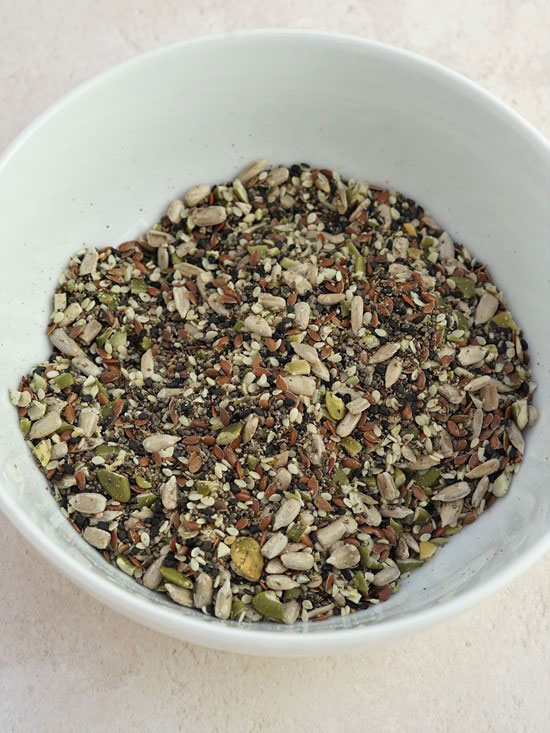
To make my Seeded Scottish Oatcakes, you can use any combination of seeds you like. I roughly chop bigger ones like pumpkin seeds so they’re less intrusive. Because it’s thought that you get more nutritional benefits from some seeds when they’re ground (e.g. chia and flax), you can replace some of the whole seeds with ground if you prefer. For the oatcakes pictured in this post I used chopped pumpkin, whole sunflower, flax, sesame, and chia plus ground chia.
OTHER INGREDIENTS
Besides the seeds, the only other ingredients you’ll need are as follows.
- Oats. The oats you buy for making porridge are fine for making oatcakes. Here in the UK, they’re labelled rolled/jumbo or porridge oats. Rolled/jumbo are larger and less flaky than porridge oats and will give you a coarser, more rustic oatcake.
- Oatmeal. Although in the US the word oatmeal usually refers to what we call porridge, here oatmeal means a flour that’s made from oats. Sold as fine, medium, or coarse, oatmeal is easier to find in wholefood shops rather than supermarkets. However, it’s dead easy to make your own by whizzing up rolled or porridge oats in a blender or food processor.
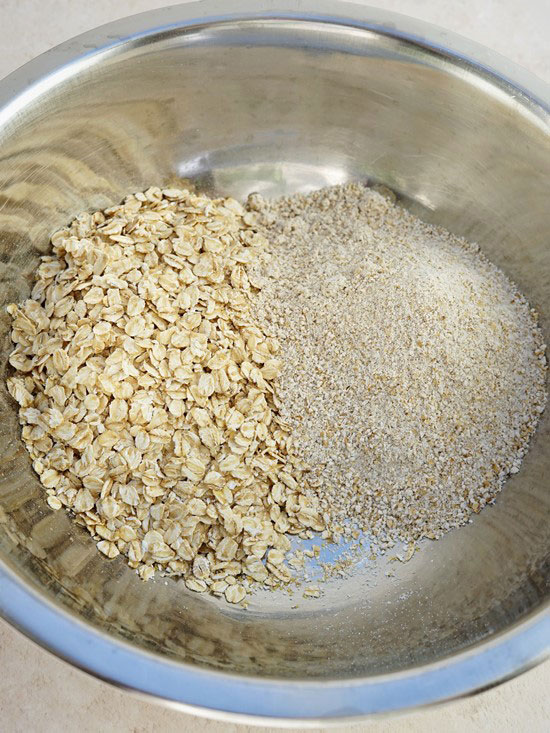
- Seasoning. I keep it simple with just salt and pepper. But feel free to add dried herbs or spices.
- Oil. Helps to bring the dough together and improves texture. Here I’ve use hemp oil to intensify the nutty, seedy flavour. But you can use almost any: sunflower, pumpkin, walnut, flax, or olive oil should all work. You could even replace it with 75 grams of melted butter if you prefer.
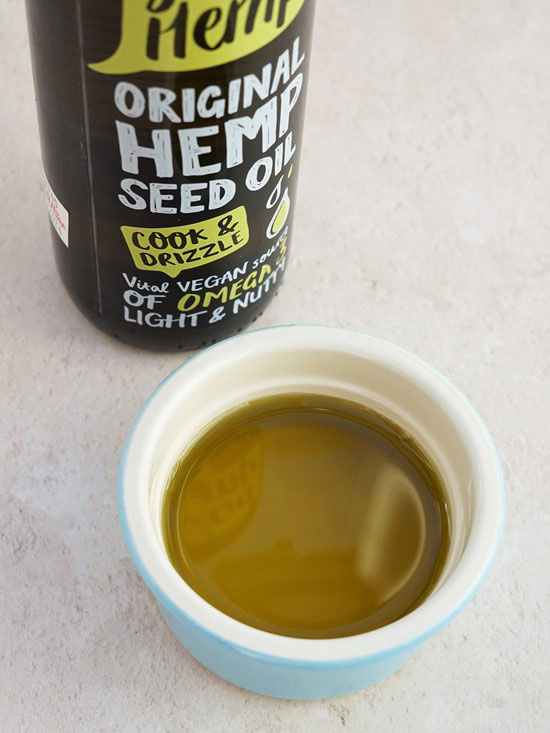
- Boiling water. Different oats absorb different amounts of water, so it’s not possible to be exact about the amount you’ll need. 100 – 120 ml is usually enough to bring the dough together, but add more if the dough still seems dry. Note that seeds such as flax and chia can absorb lots of water so including these in your mix might mean more boiling water will be needed.
- Wholemeal flour. You’ll only need a little, just to roll out the dough. You could use extra oatmeal instead, but I find wholemeal flour less sticky.
If you’re ready to start baking, then Jump to Recipe. Or read on for step-by-step tips plus photos.
MAKING THE DOUGH & ROLLING OUT
To make the dough, I start by stirring together the oats, fine oatmeal, seeds, and seasoning. Then, after making a well in the middle with my spoon, I pour in the oil followed by 100 ml of the boiling water and quickly stir to bring everything together.
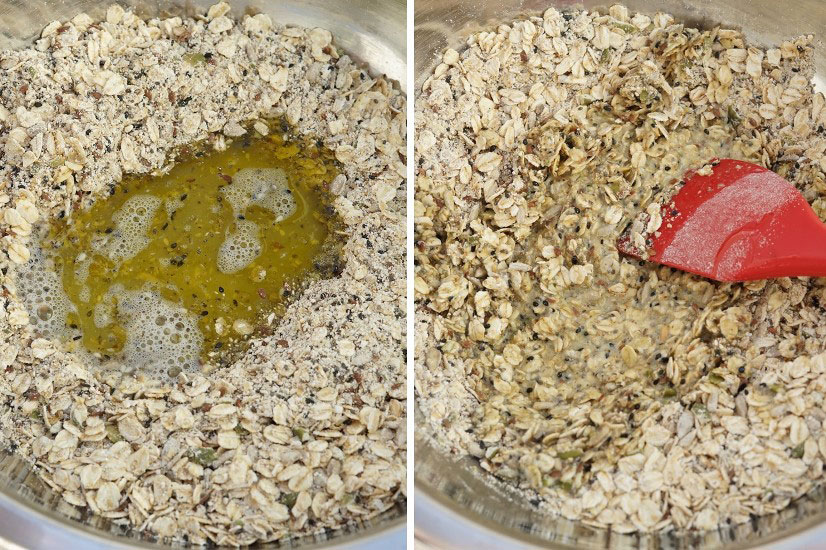
The resulting dough should be firm but not overly sticky at this point. Add more boiling water if needed to ensure it isn’t dry. Otherwise it will be difficult to roll out and cut.
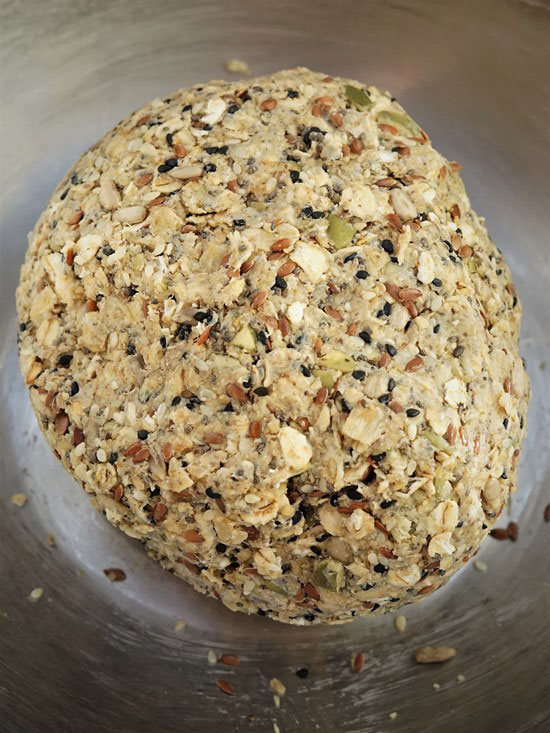
If you have a silicone mat, this will make rolling out easier. Dust it, or your worksurface, plus a rolling pin, with flour or oatmeal. To ensure the oatcakes cook all the way through and have the right crispness, roll out the dough no more than 3 – 5 mm thick. If you find the dough starts to come apart at the edges as you roll, just use your hands to push it back together and keep going.
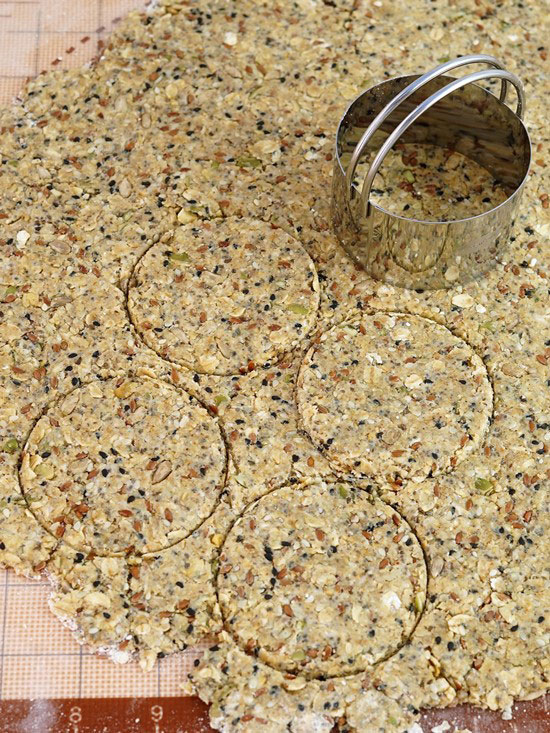
I use a 6 – 7 cm cutter, dipped in flour, to stamp out the oatcakes. Note that, when gathering up the scraps to re-roll and make more, you may need to add a few more drops of water as the oatmeal dough can be quite ‘thirsty’.
As you cut them out, place the oatcakes on a paper-lined baking tray.
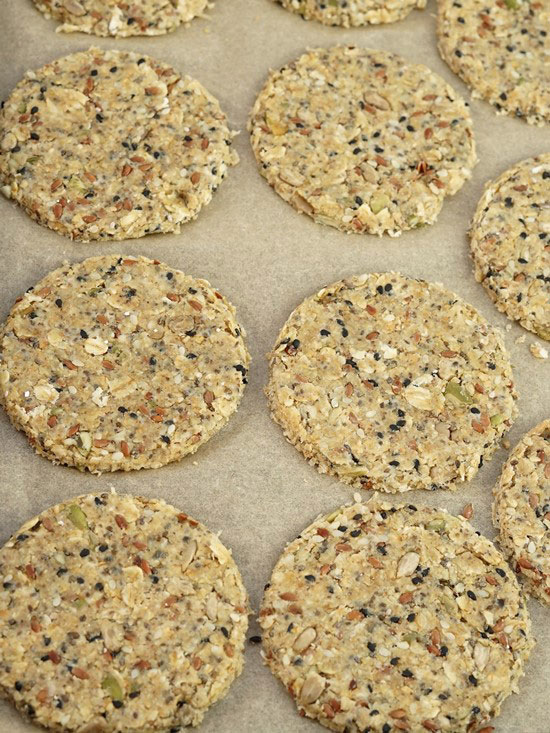
Using the same sized cutter as me, you should get around 26 Seeded Scottish Oatcakes.
BAKING & STORING
In an oven preheated to 180 C / 160 Fan / gas 4, oatcakes should take 25 – 30 minutes to get golden brown and baked all the way through. If you’ve rolled them a little thickly, they may take longer. However, oven temperatures aren’t always accurate, so I suggest you check after 15 minutes and turn the oven down if the oatcakes are browning too quickly. To get even cooking, I turn them over for the final five minutes.
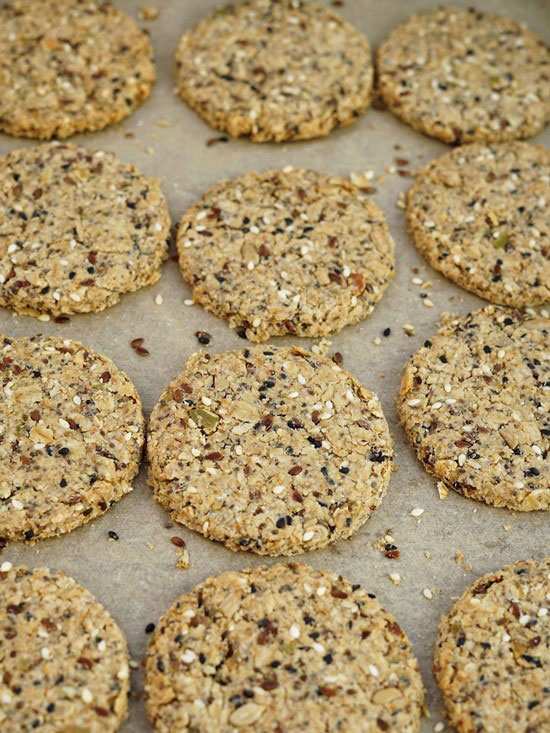
Once they’re done, transfer the oatcakes to a wire rack until completely cold. Then you can put them in an airtight container where they should keep for a good month.
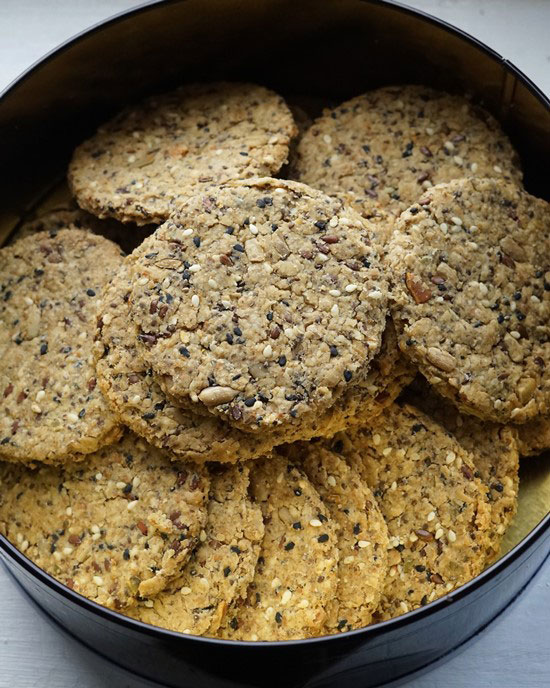
SERVING SEEDED SCOTTISH OATCAKES
I most often eat these tasty, nutritious, seedy oatcakes with cheeses, both hard and soft, or my homemade Potted Cheese. There’s something about the contrast between the creamy dairy and nutty, crispy, almost nutty biscuits that’s just so good.
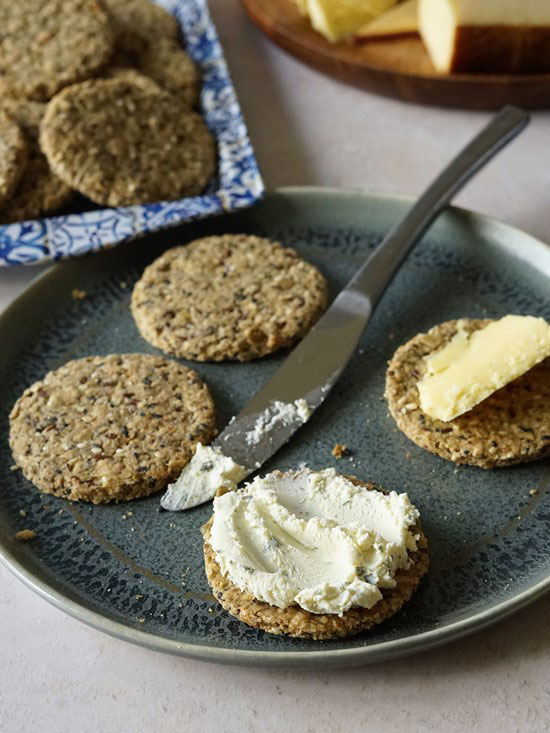
Whether you have them for lunch or part of a more elaborate cheeseboard, I think you’ll love them too.
But Seeded Scottish Oatcakes aren’t just for cheese. Try them topped with pâté like Smoked Mackerel Paté or dips and spreads like Roasted Red Pepper Hummus, Artichoke Spread with Garlic, Lemon & Mint, or creamy, smoky aubergine Baba Ganoush.
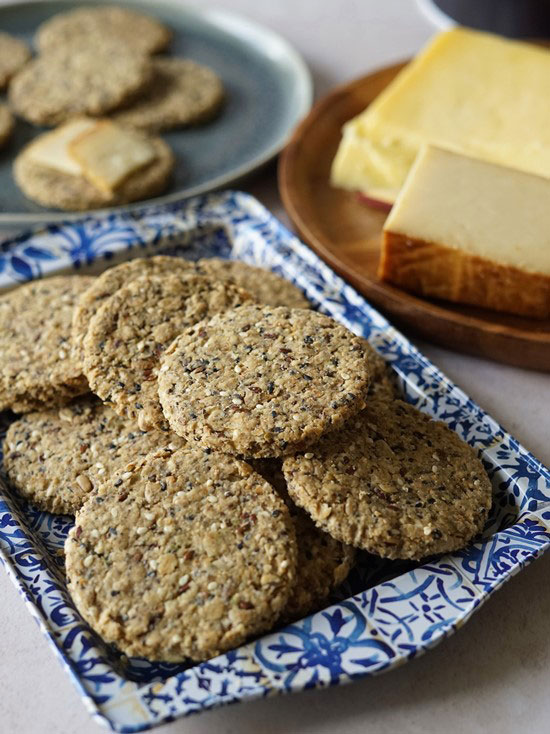
For me, these oatcakes have such a great flavour that I sometimes grab one as a quick snack, without a topping. Or you can pop a couple in packed lunches for a healthier treat.
Surprisingly easy to make, I hope you’ll try these and my other Scottish oatcake recipes. Please do let me know what you thought in the comments.
UPDATE: Now try lightly sweet Fruit & Seed Scottish Oatcakes
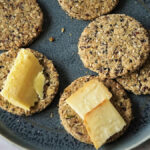
Seeded Scottish Oatcakes
Easy, wholesome savoury biscuits or crackers with tasty seeds. Eat with cheese, pâté, nut butters, alongside soup, or on their own as a nutritious snack.
Ingredients
- 140 g rolled oats or porridge oats
- 140 g fine oatmeal see Recipe Notes #1 and #2
- 140 g mixed seeds e.g. flax, chia, sunflower, sesame, pumpkin, hemp hearts. See Recipe Note #3
- ¾ tsp salt
- ¼ tsp black pepper
- 75 ml oil e.g. hemp, pumpkin seed, olive, or sunflower oil
- 100-150 ml boiling water see Recipe Note #4
- wholemeal flour (for rolling out) see Recipe Note #2
Instructions
-
Preheat the oven to 180C/160C Fan/Gas 4.
Line 2 baking trays with baking parchment or greaseproof paper.
-
In a bowl, stir together the oats, oatmeal, seeds, salt, and pepper.
-
Make a well in the centre then pour in the oil plus 100ml of boiling water.
Stir quickly to bring the mixture together into a firm dough, adding more boiling water as needed (see Recipe Note #4).
-
Lightly dust your worksurface with wholemeal flour (or oatmeal: see Recipe Note #2) and transfer the dough onto it.
Sprinkle the dough and a rolling pin with a little more wholemeal flour or oatmeal and roll out the dough 3-5 mm thick.
If the dough starts to come apart at the edges, just push it back together with your hands.
-
Cut out oatcakes using a 6-7cm cutter then transfer to the baking trays.
Bring together the scraps and re-roll to make more oatcakes until all the dough is used up: as the oat dough can be very 'thirsty', you may need to add a little more water when bringing together the scraps.
-
Put the trays in the preheated oven and bake until the oatcakes are golden brown and cooked all the way through. Unless you've rolled the dough very thickly or thinly, they should take approximately 30 minutes.
Tip 1: After 15 minutes, check that they're not browning too quickly and turn the oven temperature down if necessary.
Tip 2: For even browning, you may wish to turn the oatcakes over for the final 5 minutes.
-
Transfer the oatcakes to a wire rack to cool.
When completely cold, store in an airtight container. Should keep for a month.
Recipe Notes
Note #1 To make your own fine oatmeal, whizz rolled oats or porridge oats in a food processor, blender, or coffee mill until finely textured.
Note #2 I prefer to roll oatcake dough on wholemeal flour as it's less sticky than oatmeal. However, you can use more fine oatmeal if you prefer.
Note #3 Roughly chop any larger seeds such as pumpkin. You can also replace some of the whole seeds with ground: this is thought to increase the nutritional value of some seeds e.g. flax, chia.
Note #4 Don't be afraid to add more boiling water to bring the dough together if needed. Some oats are particularly 'thirsty' and you may need more water than that stated in the recipe to ensure the dough isn't dry. Flax and chia seeds can also absorb lots of water so, if including these, you may need to add additional boiling water.

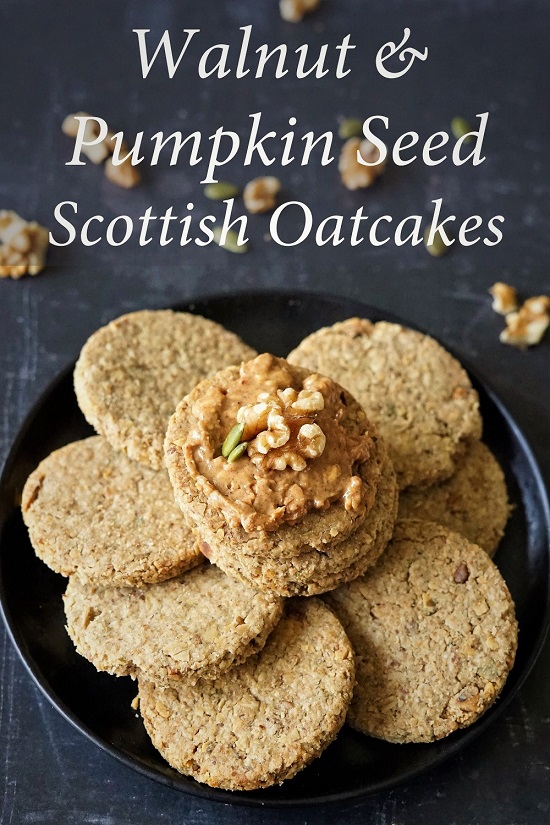


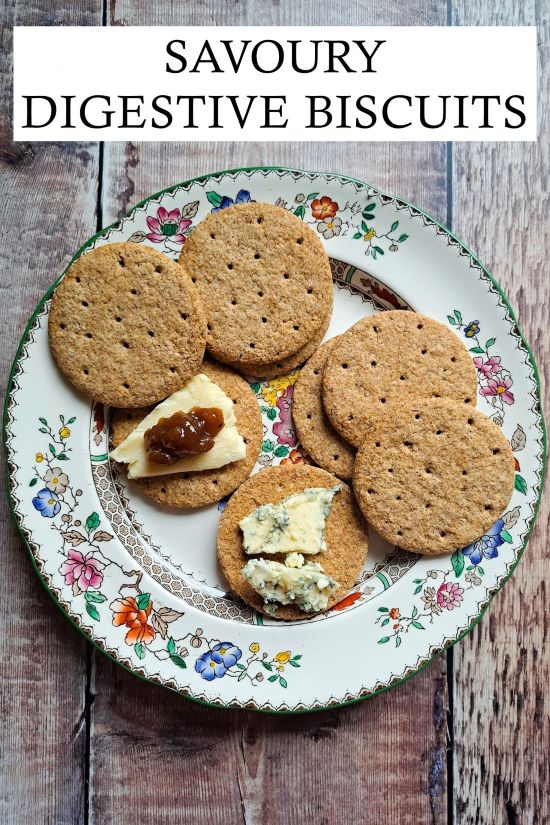
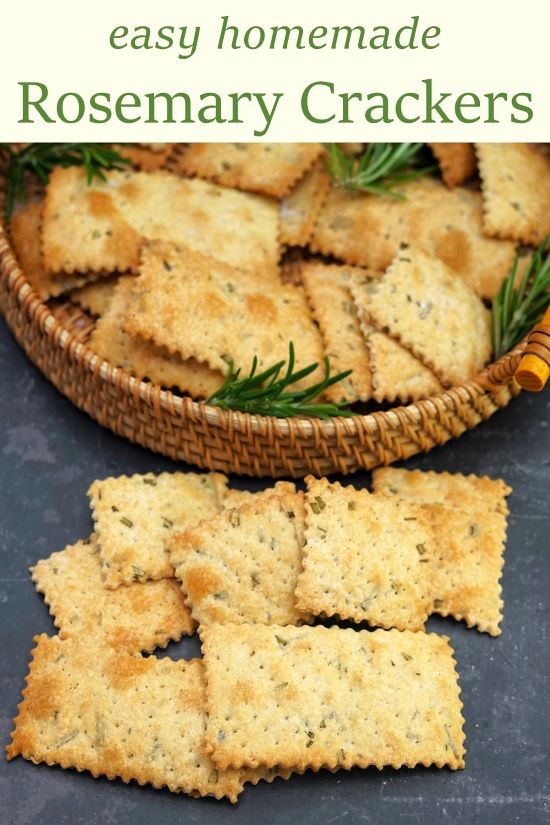
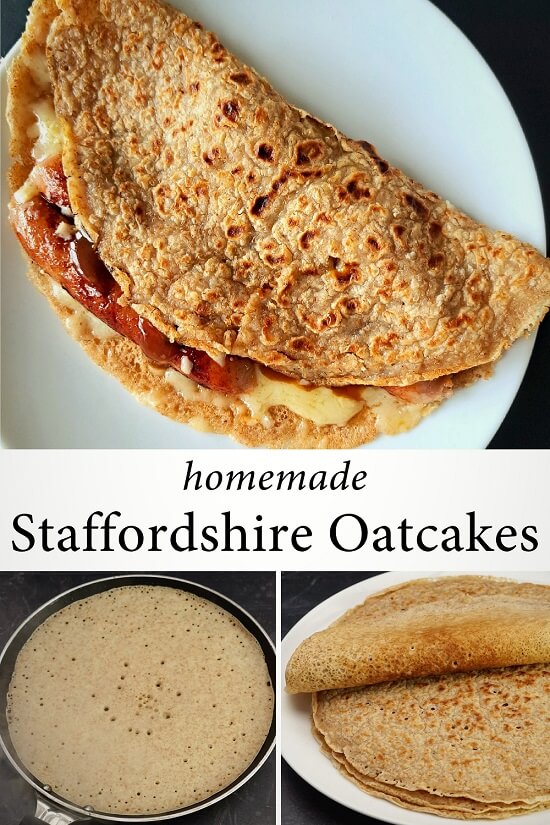
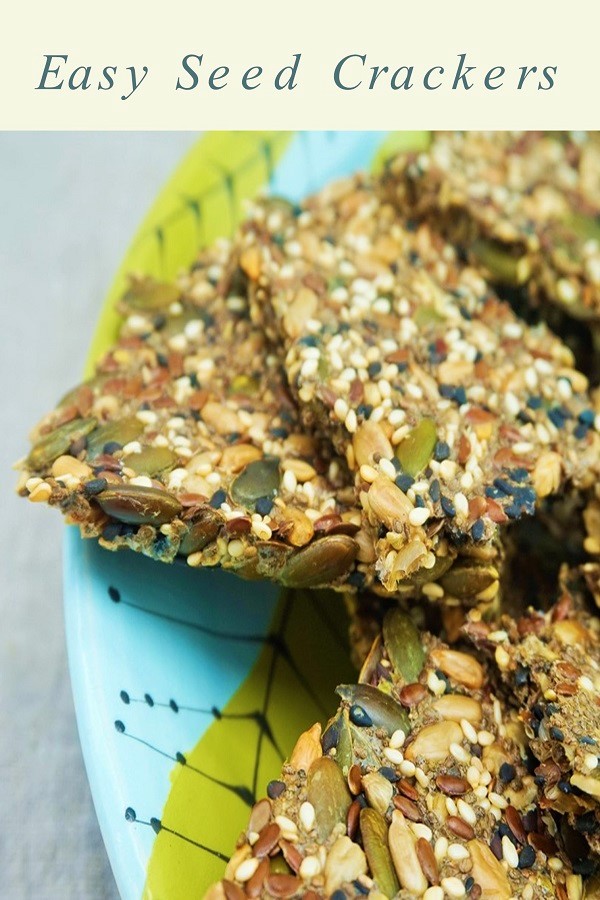

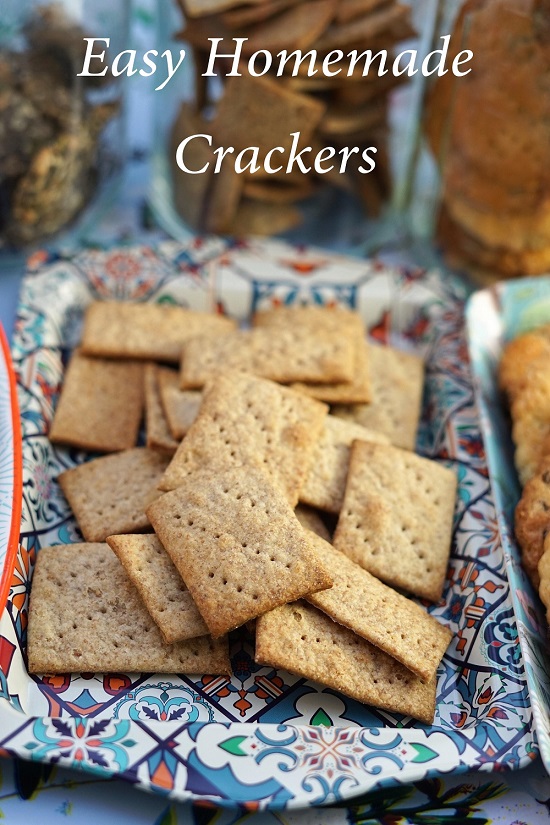
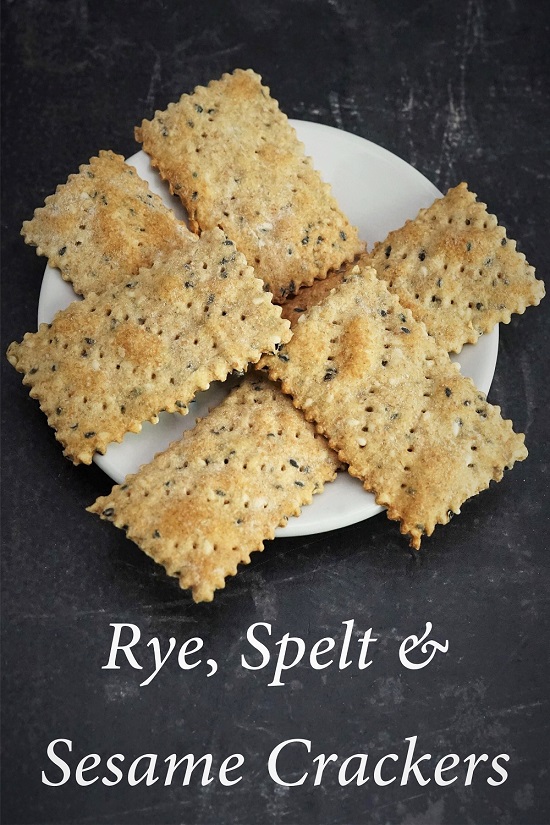
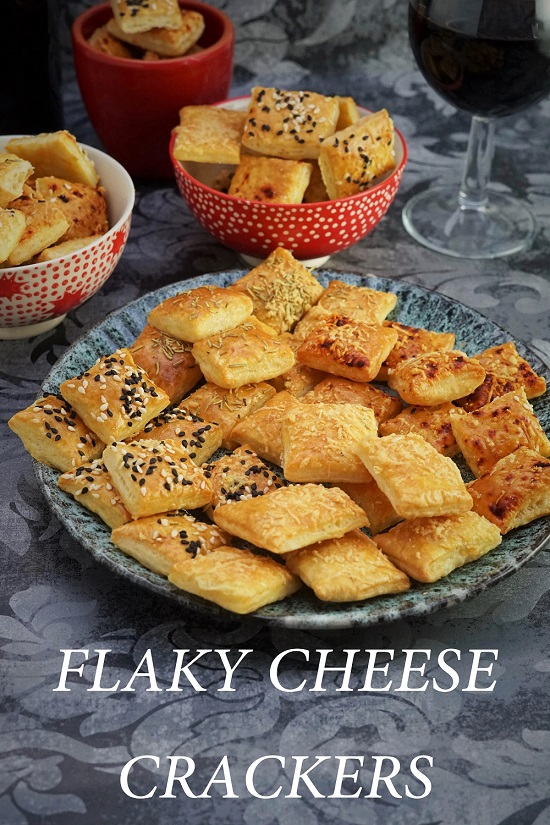
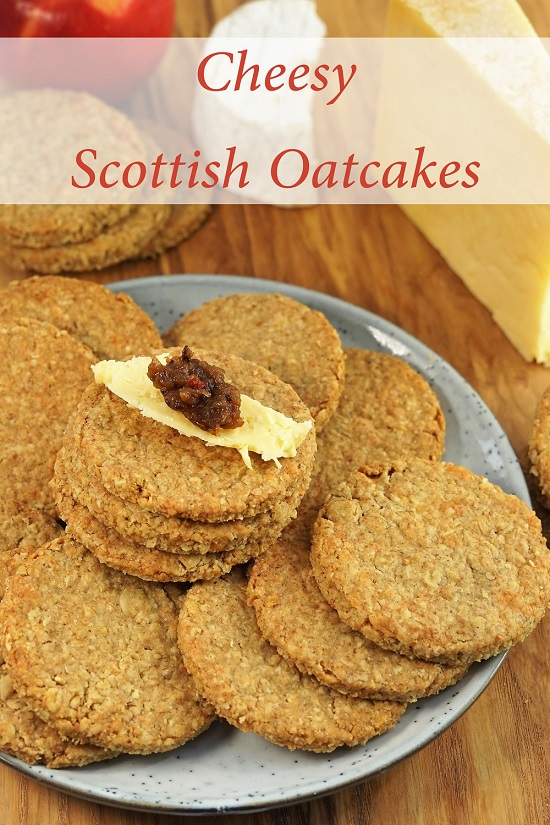
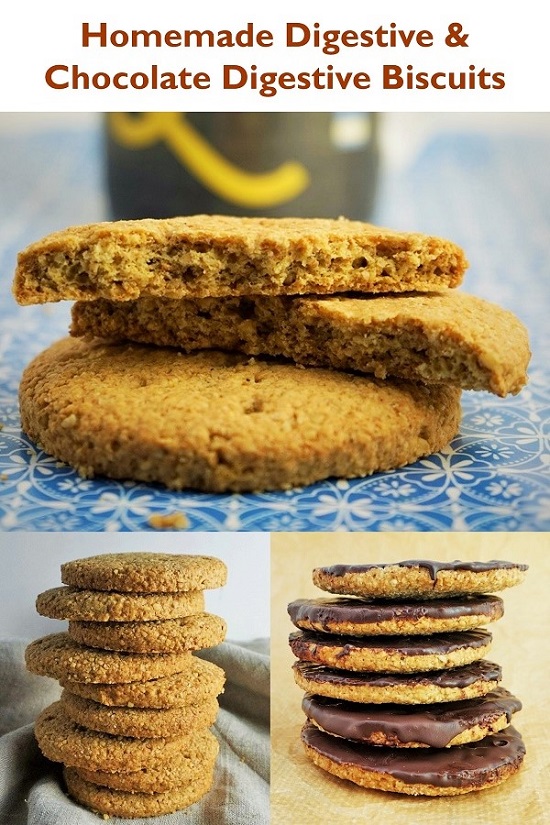
Hello Thank you so much for sharing the recipe It’s absolutely gorgeous
Very pleased you enjoyed it, Liz. And thanks so much for taking the time to give your feedback 😊
I made these seeded oatcakes using a batch of seeds previously roasted in a little soy sauce and oil. The mixture looked and felt very crumbly when rolled out, so I was rather pessimistic they would hold together. I squeezed and flattened each one lightly with my fingers before placing on baking paper. To my surprise they turned out exactly as they should. A bit crumbly perhaps, but I suppose oatcakes always are. I will do the cheesy ones next.
Thanks for this good recipe.
Glad you enjoyed the recipe!
If the mixture seems overly crumbly when rolling out don’t be afraid to add as much extra water as you need: different oats do absorb varying amounts of liquid.
Hope you like the cheesy ones too!
your recipes and photos are so inspiring. the oatcakes w cheese look especially delicious. I’m going to make them tomorrow!
Thank you Alice! I hope the oatcakes meet your expectations – do come back and let me know 🙂
I found it really difficult to bring the dough together and I ended up with lots of prebaked oatcakes which fell apart even though I added the full amount of water and sprinkled more on the re-rollings. The dough seemed to need a binder apart from the oil? I used Canola oil maybe a different oil would help?
Hi Chris, sorry to hear that, but sounds like you just needed to add even more water.
I make these (and my three other flavours of Scottish Oatcakes) all the time and the dough definitely doesn’t need any other binder other than oil and water.
A few more thoughts:
– Sprinkling your work surface with lots of flour or oatmeal when rolling out will make the dough dry, meaning it will be crumblier, necessitating more water.
– I’ve never used canola oil but doubt it would behave differently than others. I’ve made these with olive oil, hemp oil, walnut oil and melted butter with no difference to the end result.
– Did you add large amounts of those seeds which soak up lots of water eg chia or flax?
I’m sure you just needed to add more water. If the dough is dry (perhaps your oats were particularly thirsty) it won’t come together whatever you do – except add more water – and the oatcakes will fall apart.
If you try the recipe again, do let me know how it went.
p.s. Following your comment, I’ve updated the blog post and recipe to stress the importance of ensuring the dough isn’t dry. Thanks for your feedback!